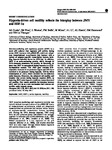Hypoxia-driven cell motility reflects the interplay between JMY and HIF-1α.
| dc.contributor.author | Coutts, AS | en |
| dc.contributor.author | Pires, IM | en |
| dc.contributor.author | Weston, L | en |
| dc.contributor.author | Buffa, FM | en |
| dc.contributor.author | Milani, M | en |
| dc.contributor.author | Li, J-L | en |
| dc.contributor.author | Harris, AL | en |
| dc.contributor.author | Hammond, EM | en |
| dc.contributor.author | La Thangue, NB | en |
| dc.date.accessioned | 2017-11-27T20:03:40Z | |
| dc.date.available | 2017-11-27T20:03:40Z | |
| dc.date.issued | 2011-12-01 | en |
| dc.identifier.uri | http://hdl.handle.net/10026.1/10339 | |
| dc.description.abstract |
Junction-mediating and regulatory protein (JMY) is a novel p53 cofactor that regulates p53 activity during stress. JMY interacts with p300/CBP, which are ubiquitous transcriptional co-activators that interact with a variety of sequence-specific transcription factors, including hypoxia-inducible factor-1α (HIF-1α). In addition, JMY is an actin-nucleating protein, which, through its WH2 domains, stimulates cell motility. In this study, we show that JMY is upregulated during hypoxia in a HIF-1α-dependent manner. The JMY gene contains HIF-responsive elements in its promoter region and HIF-1α is recruited to its promoter during hypoxia. HIF-1α drives transcription of JMY, which accounts for its induction under hypoxia. Moreover, the enhanced cell motility and invasion that occurs during hypoxia requires JMY, as depleting JMY under hypoxic conditions causes decreased cell motility. Our results establish the interplay between JMY and HIF-1α as a new mechanism that controls cell motility under hypoxic stress. | en |
| dc.format.extent | 4835 - 4842 | en |
| dc.language | eng | en |
| dc.language.iso | eng | en |
| dc.subject | Base Sequence | en |
| dc.subject | Cell Hypoxia | en |
| dc.subject | Humans | en |
| dc.subject | Hypoxia-Inducible Factor 1, alpha Subunit | en |
| dc.subject | Molecular Sequence Data | en |
| dc.subject | Nuclear Proteins | en |
| dc.subject | Promoter Regions, Genetic | en |
| dc.subject | Trans-Activators | en |
| dc.title | Hypoxia-driven cell motility reflects the interplay between JMY and HIF-1α. | en |
| dc.type | Journal Article | |
| plymouth.author-url | https://www.ncbi.nlm.nih.gov/pubmed/21625218 | en |
| plymouth.issue | 48 | en |
| plymouth.volume | 30 | en |
| plymouth.publication-status | Published | en |
| plymouth.journal | Oncogene | en |
| dc.identifier.doi | 10.1038/onc.2011.188 | en |
| plymouth.organisational-group | /Plymouth | |
| plymouth.organisational-group | /Plymouth/REF 2021 Researchers by UoA | |
| plymouth.organisational-group | /Plymouth/REF 2021 Researchers by UoA/UoA01 Clinical Medicine | |
| plymouth.organisational-group | /Plymouth/REF 2021 Researchers by UoA/UoA01 Clinical Medicine/UoA01 Clinical Medicine | |
| dc.publisher.place | England | en |
| dc.identifier.eissn | 1476-5594 | en |
| dc.rights.embargoperiod | Not known | en |
| rioxxterms.versionofrecord | 10.1038/onc.2011.188 | en |
| rioxxterms.licenseref.uri | http://www.rioxx.net/licenses/all-rights-reserved | en |
| rioxxterms.type | Journal Article/Review | en |


